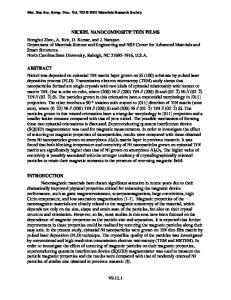Diamondlike Carbon-Metal Nanocomposite Films for Medical Applications
- PDF / 184,838 Bytes
- 6 Pages / 612 x 792 pts (letter) Page_size
- 44 Downloads / 404 Views
T1.4.1
Diamondlike Carbon-Metal Nanocomposite Films for Medical Applications R. J. Narayan1, H. Abernathy1, L. Riester2, C. J. Berry3, and R. Brigmon3 1
School of Materials Science and Engineering, Georgia Institute of Technology, Atlanta, GA 30332-0245 2 Metals and Ceramics Division, Oak Ridge National Laboratory, Oak Ridge, TN 37831 3 Environmental Biotechnology Section, Savannah River National Laboratory, Aiken, SC 29808 Abstract Silver and platinum were incorporated within diamondlike carbon (DLC) thin films using a multicomponent target pulsed laser deposition process. Transmission electron microscopy of the DLC-silver and DLC-platinum composite films reveals that these films selfassemble into particulate nanocomposite structures that possess a high fraction of sp3hybridized carbon atoms. DLC-silver-platinum films demonstrated exceptional antimicrobial properties against Staphylococcus and Pseudomonas aeruginosa bacteria. Introduction The introduction of implantable medical devices into the body has been shown to greatly increase the risk of infection. Infections involving artificial organs, synthetic vessels, joint replacements, or internal fixation devices usually require reoperation. Some infections are more serious than others; infected cardiac, abdominal, and extremity vascular prostheses result in amputation or death [1-2]. Bacteria form a glycocalyx, an adherent coating that forms on all foreign materials placed in vivo [3-5]. This 5-50 µm thick glycoprotein-based coating protects bacteria through a diffusion limitation process, and serves to decrease their antibiotic sensitivity by 10 to 100 times. In addition, the constituents of many alloys and polymers can inhibit both macrophage chemotaxis and phagocytosis. Finally, tissue damage caused by surgery and foreign body implantation further increases the susceptibility to infection. The sustained delivery of silver ions into the local micro-environment of implants systemic side effects and exceeds usual systemic concentrations by several orders of magnitude [6-8]. Silver nanoparticles have been shown to possess an unsurpassed antimicrobial spectrum, with efficacy against 150 different pathogens. Silver ions bind strongly to electron donor groups on sulfur-, oxygen- or nitrogen-containing enzymes. These ions displace other cations (e.g., Ca2+) important for enzyme function. In addition, nanocrystalline silver also provides broad-spectrum fungicidal action. Very low silver ion concentrations required for microbicidal activity (in the range 10-9 mol/l). Films containing both silver and platinum may demonstrate enhanced antimicrobial activity due to formation of a galvanic couple that accelerates silver ion release [7]. We have recently developed a variant of the conventional pulsed laser deposition process in order to incorporate antimicrobial metals during DLC film deposition. Briefly, a single multicomponent target is loaded into the pulsed laser deposition chamber. This target contains pure graphite that is covered by a piece of the desired modifying el
Data Loading...











